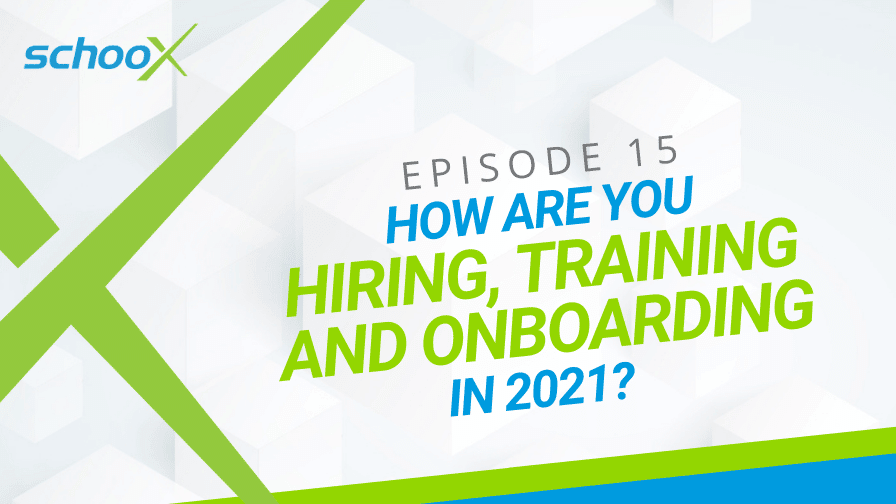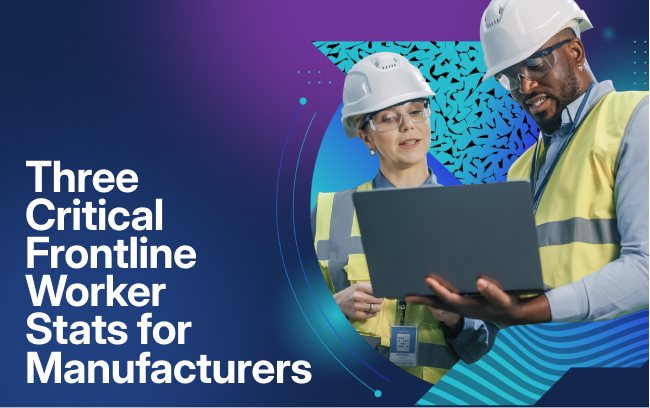January 25, 2021
7 Min. Read

How are you approaching hiring, training and onboarding in 2021?
Onboarding new hires may look very different today from how they looked this time last year. Many businesses now have a remote workforce meaning that new employees may have to be integrated and trained remotely. With traditional shoulder-to-shoulder training no longer possible for many, how can your organization succeed when hiring and onboarding virtually in 2021?
In this episode of The Learning Xchange, Schoox’s VP of Learning and Brand Success, Matthew Brown, discusses how to approach training new hires in 2021. Matthew shares why you should innovate your training approach this year and asks questions that can help you achieve this.
Listen to this episode of The Learning Xchange.
How long should your onboarding or training program be?
No two organizations are exactly alike, so there is no one-size-fits-all approach that will suit every business and each new hire. However, by putting in place a structured approach to new hires’ orientation, you can set benchmarks and gain measurable insights into performance. But how long should this orientation last?
Some organizations have orientation or training programs that last one or two weeks, while others span as long as 60 or 90 days. Your business should determine what length is best for you and your employees’ integration.
Since the pandemic, you may need to update your onboarding program length. Does it need to accommodate new ways of training? Or perhaps you need to ensure that new starters integrate remotely, successfully. In these cases, you may want to extend your onboarding length.
Having a program allows a consistent onboarding of all new hires. A set structure allows you to analyze both your employees’ progress and your organization’s impact on them. It can be overwhelming to plan an orientation period, however, there are many benefits to a longer onboarding process. We recommend a 90-day training program as this can give your new starters the continued support that they need to be successful within your organization.
What do you include in your onboarding program?
To prepare an onboarding program, you need to consider how you’ll deliver training. Do you focus on preparing training materials, or do you organize training with different team members? Will your training be in-person or virtual? Self-paced, instructor-led, or a hybrid combination of both?
Many onboarding processes include performance checklists or skill assessments. If you want to include these in your program, you should consider when and how you conduct these.
Creating a set program means you’re more likely to dedicate the necessary time to it. Often, training can get sidelined when issues or challenges arise. A collaborative approach can ensure that training responsibilities are spread across the organization, meaning that it’s more likely to stay on track.
A partnership between the learning function, hiring managers, department heads, and other key resources throughout the organization go a long way. Knowledge exists throughout your organization, so find ways to tap into it and consistently share it with your new employees.
How has your initial onboarding changed in 2021?
If your organization moved to remote working, or uses different communication methods, such as video conferencing software, your onboarding might look very different today from how it did this time last year. Does your training material reflect this?
New starters’ first week of content should be a comprehensive introduction to your systems and processes. If these have changed since the pandemic, you should revise your onboarding materials.
Another thing to consider is how you conduct this initial training. If you previously trained people in-person, but your organization is now operating remotely, you may have to adapt your training for virtual consumption. This could require a creative approach, depending on your business.
How have you shifted training from in-person to virtual?
It’s important that your online training solution is comprehensive enough to prepare new employees for when they do eventually report to the physical workplace. This will reduce the need to be shoulder-to-shoulder with their colleagues to be ready for the physical work environment.
Some businesses, for example, a restaurant, have typically used the shoulder-to-shoulder approach for training and onboarding new employees, but they’ve since innovated. Some built hybrid training pieces, including immersive, self-paced online training, which covers systems and processes. Now, they only use shoulder-to-shoulder when absolutely necessary – or even conduct training remotely.
Consider if it’s possible to train your new employees remotely. You could use video conferencing software on your phone or laptop to introduce new hires to the physical workplace. You can explain what to do in certain scenarios or test new hires’ knowledge by asking them what you should do. If you use a hybrid training model, you can use this method to find out how impactful your virtual training has been.
This also opens up a conversation about the right and the wrong way to do things. It allows the trainer to reinforce or correct learning before the new hire puts it into practice.
How do you personalize training?
A one-size-fits-all training approach can limit employee success. While a standardized training program can give you the necessary results you and your new employees need, it might not get the best out of each individual.
For big organizations, training often needs to tick a box. By working with leadership to develop and workshop your training programs, you may be able to build a solution that’s flexible, scalable, and possible to personalize.
Finding creative ways to personalize training allows organizations to strive for excellence. Everyone learns differently, and the best training will accommodate this. If you can go beyond the foundational level to build-in personalized content, your training will be more successful.
What are your training goals for new employees?
Setting goals and objectives for your new employees can help you stay on top of their progress. It can also help you support them so they can be successful.
Your goals for new employees may have changed since the pandemic. If they have, are you measuring the impact and efficacy of your training in a new way?
Many organizations prioritize and get stuck with compliance, but this doesn’t always mean that you’ve changed their behaviors or successfully taught processes. It requires a much more in-depth approach to understand how trainees have absorbed and apply knowledge.
By working with a 90-day training program, it’s possible to set checkpoints and milestones that give you insights into how the learner is progressing. Tests or knowledge checks are a simple way to understand what the new employee has learned and what they need to progress further. You can standardize or personalize these materials depending on your organization’s training approach to measure your impact on all new hires.
We’ve asked these questions to many members of the learning and development industry to build our knowledge of how people are adapting their hiring, training and onboarding processes. We’re seeing continual development as organizations begin to reach a more common approach to training this year.



